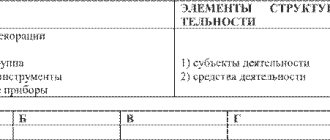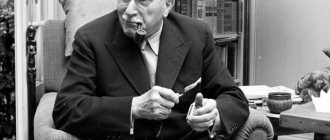In a broad sense, personality is a reflection of the social aspect of a person when analyzing him as an element of society participating in sociocultural life. Personality psychology considers a person as the bearer of a certain unique principle, which gradually reveals itself when interacting with other people within the framework of relationships provided for by society. This involves communication and different areas of activity.
The study of personality in psychology begins with defining terminology and deciphering the concept. Sometimes the word denotes an individual participating in a relationship and acting consciously. Sometimes a word denotes a system of traits that are significant to society and define a person as a member of a certain group. The concept of a person as an integral subject and seeing him as a set of traits differ in meaning, but in everyday life they are often used as synonyms.
The essence of the concept of personality
William James is considered to be the founder of personality psychology. He owns the philosophical theory of pragmatism, from which many modern trends in psychology emerged.
James is the first transpersonal psychologist. According to his theory, personality is the interaction of instincts and habits with the volitional qualities of a person.
However, the term “personality” itself belongs to N. M. Karamzin. In his understanding, a person is the master of fate, life, a spiritually rich and original person, responsible for his actions. Based on this, it can be argued that a person is not born, but becomes.
- Personality is a product of the social in man. At birth, a person has only a biological element, but immediately his formation as a person begins, that is, he assimilates social experience.
- However, there are many approaches to the interpretation of the personality phenomenon. You can read more about this in the article “Theories of Personality: Domestic and Foreign.”
- In psychology, it is customary to distinguish between the internal and external world of the individual. You can read about the first element in the article “What is the inner world of a person.” The external world refers to the relationship of the individual with society, the social environment, education and formation as a subject of society.
In order to become an individual, you need to make a lot of effort:
- master speech;
- with its help - motor, intellectual and sociocultural skills.
The formation of a person as an individual is the result of his socialization. The more information, value orientations, and traditions a person perceives and assimilates, the more developed a person he will become.
The concept of personality is closely related to the concept of the individual and individuality:
- An individual is a person as a representative of his species.
- Individuality is a set of unique distinctive features of a person.
But what’s interesting: a person can be an individual, but at the same time not be a person. Every person is unique, but not everyone becomes a person.
Thus, if we talk about a person as an individual, we mean a social element in our nature. While when discussing a person as an individual, the biological element plays a large role.
The process of personality formation is a holistic and interconnected process of formation of the needs, interests, worldview, beliefs and ideals of a particular person.
World of Psychology
There are different definitions of the concept “personality”.
1st group: a universal human approach, from which various specific sciences emerge, for example, the definition of K. Marx: “Personality is the totality of all social relations.”
2nd approach: sectoral, which starts from the subject of a particular science, for example, social sciences define Personality as the quality of a subject.
3rd approach: specific conceptual author’s definitions within the same science, but different in their content.
Personality is a specific person, taken in the system of his stable socially conditioned psychological characteristics, which manifest themselves in social connections and relationships, determine his moral actions and are of significant importance for himself and those around him (Maklakov A.G.)
Personality , on the one hand, denotes a specific individual (person) as a subject of activity, in the unity of his individual properties (individual) and his social roles (general). On the other hand, personality is understood as a social property of an individual, as a set of socially significant traits integrated in him, formed in the process of direct and indirect interaction of a given person with other people and making him, in turn, a subject of work, cognition and communication” (I. S. Kon).
Personality is a set of social relations realized in diverse activities (Leontiev). Personality is a relatively late product of socio-historical and human development in ontogenesis (Leontyev).
Personality is a set of internal conditions through which all external influences are refracted (Rubinstein).
Personality is a social individual, an object and subject of social relations and the historical process, manifesting itself in communication, in activity, in behavior (Hansen).
Personality is the subject of social behavior and communication (B.G. Ananyev).
Personality is a person as a social individual, a subject of cognition and objective transformation of the world, a rational being with speech and capable of work (A.V. Petrovsky).
Personality is a person as a carrier of consciousness (K.K. Platonov).
Personality is an integral concept that characterizes a person as an object and subject of biosocial relations and unites in him the universal, socially specific and individually unique (B.D. Parygin).
A personality is a subject of social relations, i.e., a personality is determined by its attitude to the surrounding world, to other people, to the environment. These relationships are realized in activities, with the help of which a person can express himself and develop as a Personality.
Along with the concept of “personality,” the terms “person,” “individual,” and “individuality” are often used in science. Let's look at their differences.
A person as a species is a representative of a very specific biological species (a species of living beings), distinguished from other animals by specific specific characteristics and the level of physiological and psychological development, endowed with consciousness, capable of thinking, speaking and making decisions, controlling their actions, actions, emotions and feelings .
The concept of “individual” characterizes a person as a bearer of certain biological properties. An individual is a person as a holistic, unique representative of a species with its psychophysiological properties, which act as a prerequisite for the development of personality and individuality.
The concept of a person as an individual expresses two main characteristics:
- a person is a unique representative of other living beings, a product of phylo- and ontogenetic development, a bearer of species traits;
- a separate representative of the human community, a social being that goes beyond natural (biological) limitations, uses tools, signs and through them masters his own behavior and mental processes.
Being born as an individual, a person is included in the system of social relationships and processes, as a result of which he acquires a special social quality - he becomes a person. This happens because a person, being included in the system of social relations, acts as a subject - a bearer of consciousness, which is formed and develops in the process of activity.
A personality is a specific person who is a representative of a certain society, a certain social group, engaged in a certain type of activity, aware of his attitude to the environment and endowed with individual psychological characteristics.
A person as an individual from the point of view of psychology is characterized by:
- developing self-awareness, which is the basis for the formation of mental activity, independence of the individual in his judgments and actions and focused primarily on self-knowledge, self-improvement and the search for the meaning of life;
- activity - the desire to go beyond the realized capabilities, beyond the role requirements, to expand the scope of activity;
- the presence of a self-image - a system of a person’s ideas about his real self, his expected self, his ideal self, which ensure the unity and identity of his personality and are found in self-esteem, a sense of self-esteem, level of aspirations, etc.;
- orientation - a stable system of motives: needs, interests, ideals, beliefs, etc.;
- abilities, properties and qualities that ensure the success of certain activities;
- character, which is a set of stable individual properties of a person that determine his typical modes of behavior and emotional response.
In turn, the developmental features of all these three levels characterize the uniqueness and originality of a particular person and determine his individuality. Individuality is the uniqueness of the psyche and personality of an individual, its uniqueness. It manifests itself in the traits of temperament and character, emotional and volitional spheres, interests, needs and characteristics of a person.
Thus, the concept of “personality” characterizes one of the most significant levels of human organization, namely the features of its development as a social being.
The personality structure usually includes: abilities, temperament, character, will, emotions, motivation and social attitudes. The psychological structure of a person is a holistic systemic formation, a set of socially significant properties, qualities, positions, relationships, algorithms of actions and deeds of a person that have developed during his lifetime and determine his behavior and activities.
Psychological structure of Lazursky AF. The main task of the individual is considered to be adaptation to the environment (nature, things, people, relationships, ideas, values). The degree of its activity is important. Personality is the unity of 2 psychological mechanisms: internal (mental functions) and external (attitude to the external environment and objects). The mechanisms are interconnected.
Among the many works on the theory of personality and its structure in psychology, the works of A.G. Kovaleva, V.N. Myasishchev and K.K. Platonov.
A.G. Kovalev poses the question of the holistic spiritual appearance of the individual, its origin and structure as a question of the synthesis of complex structures:
- temperament (structure of natural properties),
- orientation (system of needs, interests, ideals),
- abilities (system of intellectual, volitional and emotional properties).
All these structures arise from the interrelation of mental properties of the individual, characterizing a stable, constant level of activity, ensuring the best adaptation of the individual to the influencing stimuli due to the greatest adequacy of their reflection. In the process of activity, properties are connected with each other in a certain way in accordance with the requirements of the activity.
V.N. Myasishchev characterizes the unity of personality:
- orientation (dominant relationships: to people, to oneself, to objects of the external world),
- general level of development (in the process of development the general level of personal development increases),
- personality structure and dynamics of neuropsychic reactivity (this refers not only to the dynamics of higher nervous activity (HNA), but also to the objective dynamics of living conditions).
From this point of view, the structure of personality is only one of the definitions of its unity and integrity, i.e. a more private characteristic of a personality, the integration features of which are associated with the motivation, relationships and tendencies of the individual.
The concept of the dynamic structure of personality K.K. Platonov.
Personality orientation . The personality traits included in this substructure do not have directly innate inclinations, but reflect an individually refracted group social consciousness. This substructure is formed through education and includes beliefs, worldviews, aspirations, interests, ideals, desires. In these forms of personality orientation, relationships, moral qualities of the individual, and various types of needs are manifested. The substructure of personality orientation is closely related to legal consciousness, especially in the part that determines the subject’s attitude to compliance with the rules of law (moral principles, value orientations, worldview). Studying the orientation of an individual’s personality makes it possible to determine his social views, way of thinking, leading motives, the level of his moral development and, in many ways, predict his behavior and actions.
Social experience . This substructure combines knowledge, skills, abilities, habits acquired on the basis of personal experience through learning, but with a noticeable influence of biologically and even genetically determined personality properties (for example, the ability to quickly memorize, physical data underlying the formation of motor skills and so on.).
Individual characteristics of mental processes . This substructure combines the individual characteristics of individual mental processes, or mental functions: memory, sensations, perception, thinking, emotions, feelings, will, which are formed in the process of social life. Mental cognitive processes and other forms of reflection of reality, together with the knowledge and experience acquired by a person, largely determine such a complex integrative personality formation as intelligence, which is positively correlated with mental development. The process of formation and development of individual characteristics of mental processes is carried out through exercises.
Biopsychic properties . This biologically determined substructure combines the typological properties of the personality, its gender, age characteristics and pathological changes, which largely depend on the physiological morphological characteristics of the brain. The process of forming this substructure is carried out through training.
The various personality traits and properties included in all the named substructures form the two most general substructures: character and abilities, understood as general integrative qualities of the personality.
All these substructures are closely related to each other and appear as a single whole, expressing such a complex integrative concept as personality.
Leontiev's personality structure. The internal position of the personality or its orientation. The leading sphere is affective-need-motivational.
Rubinstein's personality structure. Dependence of mental processes on personality.
- the mental properties of a person are manifested and formed in his behavior, actions, and actions;
- the mental appearance of the individual is determined by the way of life and is formed in specific activities;
- The mental appearance of a person solves 3 questions:
- What does the person want (direction, attitudes, needs, interests)?
- What can a person (abilities) do?
- What is personality (character)?
Personality structure of Petrovsky A.V.:
- personality - as a social property is considered as individuality.
- a person is a subject of activity and relationships with other people.
- personality influences other people.
Personality structure of Yadov V.A. — Conscious behavior of the Personality. Attitudes are formed in the presence of needs (psychophysiological; family; included in groups; in the social system). The conditions of activity or situations in the realization of needs are important (in increasing importance: subject situations; conditions of group communication; conditions of activity in the social sphere; general social conditions of life). The regulation of social behavior of the Personality is important:
- behavioral acts, contact of the individual with the environment;
- habitual action or deed, correspondence between a social situation and a social need;
- professional behavior;
- integrity of behavior in human life.
In foreign psychology, there are many different theories of Personality within different schools. Summarizing the concepts, the following are distinguished:
- Personality has its own structure
- Individual differences between people are important
- Personality is formed under the influence of external and internal factors, including genetic and biological predisposition, social experience and the external environment.
- Personality influences behavior; thanks to its content, a person has constancy for a long time and under different conditions.
Activity and orientation of the individual.
The basis of a person as an individual is his own activity. It is not identical to activity. Activity and activity are independent of each other. Activity has an objective character, in contrast to activity, which is symbolic. Activity is manifested in the relationships in which a person is involved and which he builds by performing some activity.
Voluntary and involuntary activity are distinguished. Voluntary activity manifests itself in achieving a certain result, in the form of pre-set goals, controlled during the process itself. Involuntary activity associated with experiences, sleep, dreams. With this type of activity, a person reflects passively. Involuntary behavior includes: reflex responses (for example, the blink reflex); indicative reaction; wrong actions.
The source of human activity is needs. The needs are characterized by the following characteristics:
- every need has its own subject;
- every need acquires specific content depending on the conditions and method in which it is satisfied;
- need has the ability to reproduce.
Since needs are always accompanied by subjective experiences (desire, anxiety), they encourage a person to take certain actions, actions aimed at satisfying needs, and needs give rise to motive.
Motive is an incentive to activity associated with satisfying the needs of the subject and determining the direction of action.
Personality orientation.
Despite the existence of different scientific approaches to personality, everywhere its orientation stands out as the leading characteristic. Directionality is viewed differently in different concepts:
- As a dynamic tendency (L.S. Rubinstein);
- As a meaning-forming motive (A.N. Leontyev);
- As a dominant attitude (V.L. Myasishchev);
- As the main life direction (A.S. Prangishvili).
However, Orientation is revealed in the process of studying the entire system of mental properties and states of the individual: needs, motives, interests, value orientations, etc.
Orientation acts as a system-forming property of a personality that determines its mental make-up.
Direction is a set of stable motives that orient the behavior and activity of an individual, regardless of specific conditions.
The main role of personality orientation belongs to conscious motives. The orientation of the individual is always socially conditioned and formed through upbringing. Direction manifests itself in hierarchically interconnected forms:
- Attraction is a primary emotional, still unconscious manifestation of a person’s need for something.
- Desire is a mental state that expresses awareness of a need, its objects and possible ways of satisfaction, or a fully realized need and attraction to something very specific.
- Aspiration is associated with a volitional component, which manifests itself in the fact that a person is able to overcome all obstacles, difficulties, and adversities on the path of the object of need. Aspiration is inseparable from feelings.
- Interest is a mental state that provides direction to the Personality. Interest, like motive, arises in conditions of information deficiency, when a person does not receive enough knowledge that he would like to have.
- Addiction is a mental state that expresses the selective orientation of the Personality towards a certain form of activity.
- An ideal is an image of the desired final goal that guides the Personality at the present time and which plays a decisive role throughout all its activities and actions. Ideal is the dominant motive of activity and attitude of the Personality.
- Worldview is a person’s system of views on the world around him and his place in it, which guides a person in his activities and behavior. The presence of a worldview is an indicator of the maturity of the Personality.
- Beliefs are the conscious motives of a Personality, prompting him to act in accordance with his value orientations, ideals, views, and principles.
The need-motivational sphere constitutes only a part of the personality and serves as its foundation on which a person’s life goals are formed.
Personality structure
The structure of personality includes orientation, temperament, character, abilities, features of the course of cognitive processes and feelings.
Personality orientation
It includes:
- interests,
- inclinations,
- needs,
- motives,
- ideals.
Direction determines the activity of the individual and the levels of its development. The main component of a person’s orientation is a worldview (a system of views on the development of society, nature, consciousness, beliefs). You can read more about this element in the article “Personality orientation - what is it in psychology.”
Temperament
This is a set of individual characteristics of a person that characterize the dynamic and emotional side of his activity and behavior. You can read more about temperaments here.
Character
A complex of individual, most pronounced, stable character traits. Through them, a person’s attitude to reality is revealed. Behavior depends on character.
Capabilities
These are properties of the psyche and its systems, expressed to varying degrees. The success of mastering and performing activities depends on them.
The problem of personality in psychology
Psychology studies the problem of personality from a cross-section, since the manifestations are diverse, contradictory, and a person’s behavior is often mysterious when viewed from the outside. Elaboration of the problem is necessary for a comprehensive analysis of processes:
- will;
- thinking;
- sensations;
- emotions.
Personality in psychology is the highest integration level of processes occurring in the psyche. A comprehensive study shows what the sensory organization, emotions, and intelligence of a person are.
Personality is an integrating base, a core that connects processes and transforms actions into consistent actions, subject to a certain logic.
Methods and approaches to the study of personality
Studying the problem of personality in psychology involves the help of pedagogy, taking into account the influence of age and ethnicity. The general theory is influenced by developmental psychology, religion and work, psychosomatic medicine, parapsychology, and ideas about the superconscious.
Personality psychology is a scientific direction that was formed during the crisis of Wundtian psychology against the background of the obsolescence of atomistic theory. Multi-level study gives an idea of the psychological make-up of a person - in general, in particular, using individual examples.
Psychological characteristics and personality traits
Features of human personality in psychology:
- temperament;
- capabilities;
- preferences;
- interests;
- character.
More details:
- Temperament is an innate specificity of the nervous system. It is determined by nature and determines certain qualities. The term was introduced by Hippocrates, who proposed 4 forms of the phenomenon: melancholic, sanguine, phlegmatic, choleric. Academician I.P. Pavlov proposed 3 basic components to which higher nervous activity is subordinated: strength, balance, mobility. Combinations of components determine temperament.
- Abilities are personal properties necessary to perform the chosen activity. Without constant development they fade away.
- Preferences imply a predisposition to a particular field of activity.
- Interest is a conscious orientation, interest in information in a specific area.
- Character implies stable personal characteristics determined by upbringing and self-education. This is an acquired characteristic that changes throughout life.
Psychology of behavior
Psychology of personal behavior - behaviorism - is a science that was formed in the last century in North America. The founder of the theory, J. Watson, proposed considering behavior as the key subject of psychology. In behaviorism, behavior is a complex of behavioral reactions characteristic of a person, and each reaction is caused by a certain stimulus. In the presence of reinforcement, the connection between the response and the stimulus is strengthened. As a rule, behavior is determined by the expectation of positive reinforcement, in some cases by the desire to avoid negative reinforcement. Behaviorism implies the ability to form any type of personality using the connection of reactions and stimuli.
In behaviorism, personality is an organized, stable system of skills, which is the basis of stable behavior. Skills are adapted to real situations, and new ones are formed when things change. Human programming is carried out through changing incentives and reinforcement.
Motivational-need sphere as the basis of personality
Needs are the driving force of a person’s activity.
- Need is the body’s need for certain conditions, without which life is impossible.
- Motive is an objectified need.
- A set of motives aimed at a goal is motivation.
The need to understand the world is the most important for an individual. It frees a person from the captivity of fears, misunderstandings and superstitions, and allows him to be the creator of life.
Other spiritual needs are no less significant for the individual:
- in aesthetic pleasure;
- in labor;
- in social activities;
- in communication.
The development of needs (from lower to higher) is a condition for personality development.
Theories and concepts of personality development
There are many theories and concepts of personality development. There are the most important of them, which psychologists still use in their work to this day.
Personality orientation - what is it in psychology, its types
In general, there are 2 main concepts that represent personal development. These include:
- Biological (biogenetic), based on which the person himself is considered as a being created by nature, whose behavior depends on drives, needs or instincts.
- Social (sociogenetic), in which the most important factor is the environment where a person develops and socializes.
Note! There is also a recently developed concept that consists of the two above. That is, the biological nature of a person influences the ongoing mental processes, and the sociological nature influences the interests and orientation of the individual. This concept is called “biosocial”.
Aspects of personality
Personality can be considered in 3 categories:
- properties of the person himself, or the intra-individual aspect;
- features of the individual’s interaction with other people, or the interindividual aspect;
- the impact of personality on other people, or the meta-individual aspect.
Through the analysis of these aspects, one can characterize the inner world of a person.
A personality is a representative of a specific society or social group, engaged in a specific type of activity, aware of his relationship to the world around him and having certain individual psychological characteristics.
Psychology of human interpersonal relationships
The psychology of personal relationships considers interpersonal connections as a complex interaction between people, determined by relationships in society. Relations in society are official, fixed at a formal level. These are effective objectified interhuman connections. Interpersonal relationships are those experienced by the subject, mutual connections between people that can be realized. They are determined by emotions, nuances of the psyche. This is an expressive relationship, rich in emotions.
Interpersonal relationships are formed:
- cognitive aspects;
- affective aspects;
- behavior.
Cognitive, gnostic – cognition, understanding and awareness of information. Affective – emotional experiences due to mutual connections between persons. The behavioral aspect is realized by actions - friendly behavior, difficulties of interaction. It is carried out according to the norms programmed in culture and society.
Vertical and horizontal interpersonal relationships are possible. In the first case, the status of the participants is different, in the second - equal.
In the formation of interpersonal relationships, interpersonal compatibility plays an important role. It is determined by similarity, mutual complementarity and is expressed in satisfaction from mutual action and the results of this action. Against the background of compatibility, mutual sympathy often appears. The opposite phenomenon is incompatibility, which provokes antipathy.
Difficulties in understanding a person as an individual
The difficulty of clearly representing and describing the phenomenon of personality lies in the ambiguity of the theory. The following problematic positions can be identified:
- Often the personality is identified with the individual.
- Sometimes a person refers to a part of the inner world or a feature of the mental structure.
- Personality is regarded as a certain component that includes something given from birth, and some unattainable ideal, and a set of social relations.
- As many sciences that study man as there are and researchers who ask this question, there are as many definitions of the term “personality.”
Personality is characterized by the system of its conscious relationships. Recently, it has become popular to talk not only about the influence of social and biological factors, but also about the role of the situation as a restraining element of the individual.
Conditions for the process
The source or driving force for personal development is the person himself.
Internal positive or negative forces
Regardless of desire, there can be an influence within each person that either pushes towards something or pushes away. Processes constantly occur inside, associated with unconscious actions of the body or soul, which are based on habits, fears or natural inclinations. The child, as a rule, lives with a positive attitude and in a bright world, but over time this changes. For a mass type personality, the essential driver of activity is negative motivation. Therefore, depending on the assigned tasks and emerging situations, a developed personality tends to use both negative and positive motivation.
Personal conscious initiative
The conscious and strong-willed choice of a person who develops himself independently and fairly can become an example for everyone.
Note! In addition to the fact that the driving force behind personal development can be a person with a strong character, it is also possible that external factors influence it. The main one is the surrounding society, for example, parents, school, and other institutions.
Afterword
Despite the fact that most scientists are of the opinion that individuals are made and not born, the question of whether all people are individuals continues to attract controversy and controversial opinions.
- The question of whether a child can be considered a person is controversial, although humanistic pedagogy argues that, undoubtedly, it can and should be.
- The understanding of a mentally ill person or a criminal as an individual is just as controversial.
- Don’t the phrases “asocial personality” or “degraded personality” look ridiculous?
In the end, everyone chooses for themselves which side they belong to in these issues. In my opinion, each person (especially important for young children when raising) can be treated as a potential personality, that is, given a few points head start. However, this is possible until a person proves otherwise.
The appearance of a subject is accompanied, accordingly, by the emergence of a scientific theory.
The first theory of personality I would include the work of such an author as William James , a very important American philosopher and psychologist.
He was also the first to put forward such a concept as the human self , and psychoanalysis . He identified three types of human self - physical, social and spiritual. Since the Self is what a person identifies himself with, accordingly, three worlds arise here - the physical world, the social world and the world of spiritual values, as three components of the human Self.
The second name that I would note is a psychologist who, unfortunately, is not often mentioned undeservedly and this was the German psychologist William Stern. William Stern made a very great contribution to various areas of psychology, including practical psychology. He created one of the world's first institutes of practical psychology, Stern finally formulated the concept of IQ “intelligence quotient,” and he also introduced the concept of differential psychology. He made a huge contribution to the development of child psychology. That is, his contribution is multifaceted. But in this case I am interested in a slightly different context. Stern called for the creation of such a broad movement as personalism . It is known that in Latin persona is a person . Accordingly, in the same form the word entered other European languages. He came up with the idea of creating such a personalism movement. What does this movement mean? Stern realizing that by the beginning of the 20th century psychology had become fragmented. I tried to draw the attention of psychologists to the following phenomenon, so that every psychologist does not study someone studying perception, someone studying memory, someone thinking, someone other mental processes. Whatever every psychologist studies, one must understand that the mental phenomenon being studied turns out to be one of the diverse creations of a single, integral personality.
Whatever phenomenon we study in our laboratory, it is important to understand that it does not exist on its own, it is one of the creations of the entire psyche.
The category of personality was placed at the forefront, and all other psychological concepts were derived from it. In this case, the fragmentation of psychology, he believed, could possibly be overcome. Stern's personalism never became a theory of personality, despite all his efforts and merits.
The first specific psychological theory of personality was psychoanalysis.
But personality is not the exclusive property of psychology, no matter how zealously psychologists wanted to privatize it and make it exclusively their property. Nevertheless, personality is a common object for different sciences, and each of these sciences highlights its own subject in personality. How does each science single out its subject in this large object called personality? Very simple. Isolating an object from an object, cutting out such a narrow object into a large object is always determined by the goal, that is, by what I want to reveal, by what I want to receive. It is clear that each science has its own goals and, in accordance with them, each science in this general object carves out its own narrow sector, its own subject.
Let me give you an example: are historical sciences interested in personality? Yes, of course, but they are not interested in everything. Since the historian not only describes the facts of the past, but like any science, history tries to explain the process of historical development and identify its patterns. In the process of identifying the driving forces of historical development, historians turn to specific individuals.
On the one hand, we understand that there are probably objective laws of social development. These laws, for example, lead to a change in socio-economic formations to revolutions or evolutionary development.
These are objective laws of the development of society, but very specific historical events are created by the hands of living, specific people, and we can always name their names. Lenin and the Bolsheviks staged the October Revolution, seized power first in Petrograd, and then began to seize it in the rest of the cities of Russia. It was Lenin who arranged everything. Then a question arises for the historian, but it is interesting to know to what extent different historical events are caused by the action of general objective laws of history? Are these objective laws of history operating through the hands of specific people? Nothing depends on a specific person; there are objective laws of history and specific people are simply their executors. Or are these historical events to some extent determined by the actions of a particular person? Because it was Lenin, it was he who chose such a good moment, because he had certain personality traits? This problem is what historians call the role of personality in history.
Essentially the historian is trying to answer the question. To what extent are historical events determined by the actions of a particular person? To what extent is a person not free to influence the objective course of history? Sociologists are also interested in personality in their own way, and even in sociology itself there is such a branch or section - this is the sociology of personality. And sociologists are interested in personality exclusively as an element in various social processes, that is, in various forms of unification of people. From this point of view, the personality is interesting to them; everything else does not affect the interests of the sociologist.











